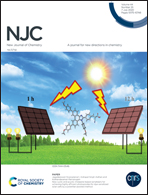Transport and photoelectric properties of vertical black phosphorus heterojunctions
Abstract
The electronic structures and transport properties of the heterojunctions (X/BP) (X = BN, MoS2, or graphene) formed by vdW interactions of black phosphorus (BP) with insulative BN, semi-conductive MoS2, conductive graphene (G), and their corresponding intercalation composites X/Pt/BP and X/PtCl2/BP constructed by encapsulating Pt and PtCl2 into the heterojunction layers have been explored using density functional theory (DFT) and the nonequilibrium Green's function (NEGF). The linear photogalvanic effects of Pt and PtCl2 on the intercalation composites have been further studied by employing Keldysh nonequilibrium Green's function (KNEGF) methods. The BP and X layers are packed in a zigzag–zigzag (also an armchair–armchair) orientation. The band edges of BN/BP are mainly contributed by BP with a type-I alignment. The valence band of MoS2/BP is controlled by BP while the conduction band is dominated by MoS2, leading to a type-II alignment. Both BP and G contribute to the valence band and the conduction band; moreover, the Dirac-cone band ribbon of G and the direct band gap of BP are preserved in G/BP. For BN/BP-based systems, intercalating PtCl2 could largely improve the conductivity compared to inserting Pt. However, the case is exactly opposite in the G/BP-based species, where the conductivity of G/Pt/BP is much larger than those of G/PtCl2/BP and G/BP. While for MoS2/BP-based systems, Pt and PtCl2 exert similar effects on conductivity. Evident anisotropic transport property is found for BN/BP-based and G/BP-based systems, while no obvious anisotropic feature is observed for MoS2/BP-based systems. Under linear illumination, encapsulating PtCl2 shows a much stronger photoresponse than Pt. The strength of the photoresponse in PtCl2-doped systems can be tuned by the irradiation angle, the photon energy, and the type of X. All these fascinating properties can be interpreted from multiple factors such as band structures, Pt(PtCl2)–BP(X) interactions and BP–X interactions. These new 2D materials are especially attractive for electronic and optoelectronic devices.



 Please wait while we load your content...
Please wait while we load your content...